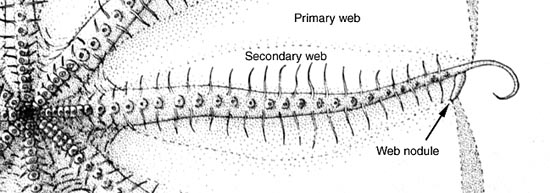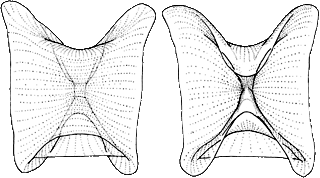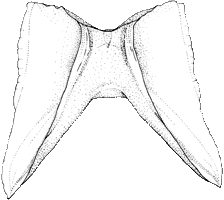Cirroteuthidae
Michael Vecchione, Richard E. Young, and Katharina M. Mangold (1922-2003)


This tree diagram shows the relationships between several groups of organisms.
The root of the current tree connects the organisms featured in this tree to their containing group and the rest of the Tree of Life. The basal branching point in the tree represents the ancestor of the other groups in the tree. This ancestor diversified over time into several descendent subgroups, which are represented as internal nodes and terminal taxa to the right.

You can click on the root to travel down the Tree of Life all the way to the root of all Life, and you can click on the names of descendent subgroups to travel up the Tree of Life all the way to individual species.
For more information on ToL tree formatting, please see Interpreting the Tree or Classification. To learn more about phylogenetic trees, please visit our Phylogenetic Biology pages.
close boxIntroduction
Species in the family are entirely pelagic and have a very fragile, gelatinous structure and eyes that vary from large to small to degenerate. They are usually found in association with the ocean floor (benthopelagic) at great depths. Some have, however, been caught far above the bottom and one specimen was dip-netted through an ice hole in the Arctic.
Brief diagnosis:
A cirrate ...
- with long cirri and secondary webs.
- with saddle-shaped shell.
- with anterior mantle attached dorsally to head.
Characteristics
- Shape and consistency
- Anterior-posteriorly elongation pronounced; body extends well posterior to shell.
- Anterior-posteriorly elongation pronounced; body extends well posterior to shell.
- Web
- Primary and secondary webs present.
- Web nodules present or absent.
 Click on an image to view larger version & data in a new window
Click on an image to view larger version & data in a new window
Figure. Oral view of left arm III of Cirroteuthis muelleri. Drawing modified from Voss and Pearcy, 1990.
 Click on an image to view larger version & data in a new window
Click on an image to view larger version & data in a new window
Figure. Ventral and aboral views of Cirroteuthis muelleri taken by an ROV in the Canadian Basin of the Arctic Ocean. The short, slender arm tips extend beyond the web. The web nodules are seen where the web intersects the arm from the ventral side. Frame grabs from a video taken during a NOAA/OE Census of Marine Life cruise; provided by Kevin Raskoff.
- Cirri
- Very long: Longest more than 8 times largest sucker diameter.
- Very long: Longest more than 8 times largest sucker diameter.
- Suckers
- Central portion of each arm with small, flattened suckers, nearly lacking acetabulum (i.e., aperatures may be virtually absent), on stalks that are either slender or swollen and fluid-filled.
- Central portion of each arm with small, flattened suckers, nearly lacking acetabulum (i.e., aperatures may be virtually absent), on stalks that are either slender or swollen and fluid-filled.
- Gills
- Gills with sepioid form.
- Gills with sepioid form.
- Digestive system
- Digestive tract arranged in simple U-shape; intestine short, without lateral bends
- Posterior salivary glands present on buccal mass.
- Radula present or absent.
- Digestive gland unilobular.
- Reproductive system.
- Male accessory gland complex compacted into a single mass.
- Male accessory gland complex compacted into a single mass.
- Optic lobe
- Spherical.
- Single optic nerve bundle penetrates white body.
- Shell
- Saddle-shaped: Broad saddle with two lobe-like, deeply escavated flared wings, pronounced shoulders.
References
Aldred, R. G., M. Nixon and J. Z. Young. 1983. Cirrothauma murrayi Chun, a finned octopod. Phil. Trans. Roy. Soc. Lond. 301: 1-54.
Voss, G. L. and W. G. Pearcy. 1990. Deep-water octopods (Mollusca: Cephalopoda) of the Northeastern Pacific. Proc. Calif. Acad. Sci., 47: 47-94.
About This Page

National Museum of Natural History, Washington, D. C. , USA

University of Hawaii, Honolulu, HI, USA
Katharina M. Mangold (1922-2003)

Laboratoire Arago, Banyuls-Sur-Mer, France
Page copyright © 2016 , , and Katharina M. Mangold (1922-2003)
 Page: Tree of Life
Cirroteuthidae .
Authored by
Michael Vecchione, Richard E. Young, and Katharina M. Mangold (1922-2003).
The TEXT of this page is licensed under the
Creative Commons Attribution-NonCommercial License - Version 3.0. Note that images and other media
featured on this page are each governed by their own license, and they may or may not be available
for reuse. Click on an image or a media link to access the media data window, which provides the
relevant licensing information. For the general terms and conditions of ToL material reuse and
redistribution, please see the Tree of Life Copyright
Policies.
Page: Tree of Life
Cirroteuthidae .
Authored by
Michael Vecchione, Richard E. Young, and Katharina M. Mangold (1922-2003).
The TEXT of this page is licensed under the
Creative Commons Attribution-NonCommercial License - Version 3.0. Note that images and other media
featured on this page are each governed by their own license, and they may or may not be available
for reuse. Click on an image or a media link to access the media data window, which provides the
relevant licensing information. For the general terms and conditions of ToL material reuse and
redistribution, please see the Tree of Life Copyright
Policies.
- Content changed 28 April 2008
Citing this page:
Vecchione, Michael, Richard E. Young, and Katharina M. Mangold (1922-2003). 2008. Cirroteuthidae . Version 28 April 2008 (under construction). http://tolweb.org/Cirroteuthidae/20091/2008.04.28 in The Tree of Life Web Project, http://tolweb.org/







 Go to quick links
Go to quick search
Go to navigation for this section of the ToL site
Go to detailed links for the ToL site
Go to quick links
Go to quick search
Go to navigation for this section of the ToL site
Go to detailed links for the ToL site